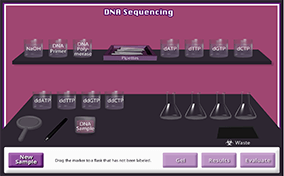What is DNA?
DNA stands for deoxyribonucleic acid. DNA is found inside every cell in an organism. DNA contains the instructional codes for the development and functioning of all living organisms. These coded instructions are passed down from parents to offspring, from ancestors to descendants, and from generations to generations.
What is the structure of DNA?
DNA consists of six connected molecules. The shape of DNA is similar to a twisted ladder. The sides of the “ladder” are made of alternating 5-carbon sugars and phosphate groups. The “rungs” of the “ladder” consist of pairs of nitrogenous bases. These bases include adenine, thymine, cytosine, and guanine.
What is DNA sequencing?
DNA sequencing is the process of determining the correct order of the nucleotide bases that are contained in the DNA structure.
Why is DNA sequencing important?
Knowing the correct order of the DNA sequence helps in the understanding of gene expression. This in turns helps in the understanding of what types of proteins are produced by the living organism.
Which fields are impacted by DNA sequencing?
Sequencing techniques are very useful in medicine, forensic sciences, agriculture, paleontology, and many other fields where living organisms exist and play a part in that field.
How might DNA sequencing be used in the future?
DNA sequencing can provide an avenue for the treatment of diseases and disorders through the use of gene therapy. Successful preliminary has already happened in the diagnosis and treatment of certain areas, such as the detection of Down syndrome, BRAC1 and BRAC2 genes, and many others.
 The making of proteins in living organisms is directed by genes coded by specific sequences of DNA nucleotides. DNA sequencing is a procedure that reveals the arrangement of the nucleotides on the two strands of the double helix DNA structure. Your challenge is to prepare and analyze a DNA sample, revealing its hidden code.
The making of proteins in living organisms is directed by genes coded by specific sequences of DNA nucleotides. DNA sequencing is a procedure that reveals the arrangement of the nucleotides on the two strands of the double helix DNA structure. Your challenge is to prepare and analyze a DNA sample, revealing its hidden code.

